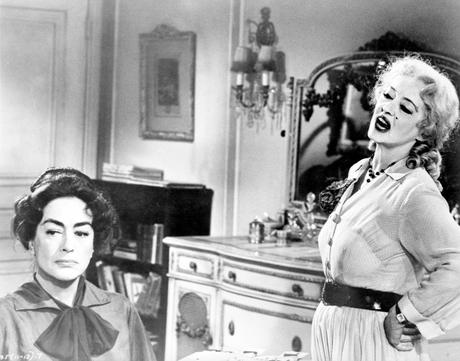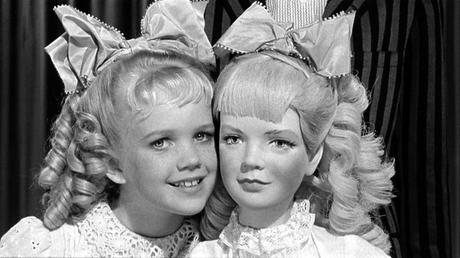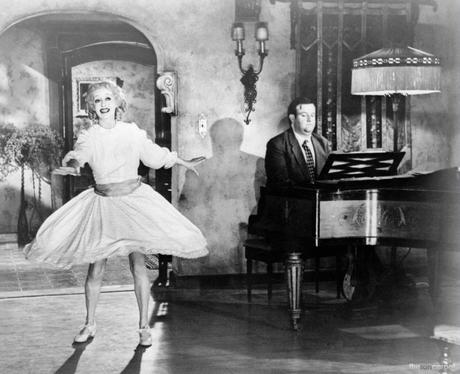
If you mention either Bette Davis or Joan Crawford, What Ever Happened to Baby Jane is bound to be one of the first movies people think of. Beyond its initial success after its release in 1962, its following of loyal fans has steadily grown over the decades thanks to the enduring appeal of Davis and Crawford together (and their oft-debated rivalry). In 2017, the FX series Feud: Bette and Joan once again renewed interest in the movie. But before it was a successful movie, it was a novel by Henry Farrell.
Book & Movie Differences
For the most part, the film version of What Ever Happened to Baby Jane stays pretty faithful to the book. Most of the differences are small, but often very interesting. For example, the timeline in the book is a little different than what we see in the movie. In the first scene of the movie where young Jane Hudson misbehaves after one of her performances, Blanche seems to be fairly close in age to Jane. But in the book, Blanche is just a baby when that incident occurs. The movie version of that scene combines two different events from the book — the misbehavior in front of the crowd and a later incident when young Blanche interrupts one of Jane’s rehearsals on the beach by trying to dance like Jane, which their father yells at Blanche for and their mother consoles her afterward.

Other details from the book add a little more insight to the history between Jane and Blanche. We find out that their parents had died during the 1918 flu pandemic. After the death of their parents, they went to live with an aunt who adored Blanche and was focused on helping her become a star in the movies. Once Blanche becomes a big star, it’s said that Jane only has parts in Blanche’s films rather than getting to star in her own movies as seen in the movie. There’s also less debate over whether it’s Blanche or Jane who paid for the house. It’s made very clear that Blanche had bought the house, but Jane does slip at one point and call it her house while talking to Elvira, who is quick to correct her.
We also get some great details for the present day side of the story that we don’t get in the movie. At times, Jane seems even more menacing than she does in the movie. There’s no doubt about whether Jane had been aware of Blanche’s plan to sell the house — Blanche had the chilling realization that Jane was listening in on the extension during her call to discuss it with their business manager as it happened. The whole concept of old stars finding new fame through television has a slightly more important role in the book. Not only does it bring attention back to Blanche, it’s ultimately what inspires Jane to try and revive her old act because she had seen that other former vaudevillians like Jimmy Durante and Buster Keaton were finding success on television.

One of the most significant differences is that the book gives Blanche quite a bit more attention than she gets in the movie. The version of Blanche that we see in the book is more inwardly complex. It focuses a lot on her inner thoughts, her frustrations with her physical condition, and her conflicted feelings about seeing her old movies on TV. While she is touched to (eventually) realize that she was getting fan mail because of it — which included one letter from an actor she had once been in a studio-arranged relationship with — she also worries that the renewed interest in her career would also lead to renewed interest in the accident and that people might dig up some details that had been covered up by the studio back in the day. A big motivation for deciding to sell the house is that she feels like staying there is a way of clinging to the past.
The book has a lot of details about the house that definitely reflect the “stuck in the past” aspect. In the movie, there’s a reference to the house once being owned by Rudolph Valentino, but the book says it’s located in a neighborhood that had once been popular among movie stars and Blanche was now the only star left. The rehearsal room we see Jane spending time in had been originally built for Blanche to give her space to prepare for her movies. We also get an explanation for why the house has those grates on the windows. Most surprisingly, the book mentions a set detail I’ve been obsessed with ever since I first noticed it — the fact that Jane has an empty picture frame on display. We don’t find out why, exactly, this empty frame is sitting out, but Edwin notices it while looking around the house and wonders what happened to the picture that was once in it, if it had been removed in a fit of anger or grief. (Speaking of Edwin, his opportunistic nature is shown a lot more in the book. He evaluates items in Blanche and Jane’s house like he’s an appraiser on Antiques Roadshow and every guest is bringing in something good.)

Throughout the book, there are several other differences from the movie, but a lot of them don’t really make a big difference in the grand scheme of things. For example, rather than Blanche and Jane living next door to a mother and daughter like we see in the movie, their neighbor in the book is a woman who recently moved to the neighborhood who watches one of Blanche’s movies on TV with a friend. (In the 1991 version with Vanessa and Lynn Redgrave, the neighbors are again changed to a married couple.) Many of the biggest differences come rather late in the book. After Edwin finds out about Blanche and flees the house, Jane realizes that he’s going to tell the police and tries to run him down with her car, attracting the attention of other people in the neighborhood. Blanche also makes some efforts to get help which end up being devastatingly futile.
During the beach scene, does it make a significant difference that police are alerted to Blanche and Jane’s presence by beachgoer annoyed by Jane’s parking job in the movie and by a couple at a nearby beach house after Jane blocks their driveway in the movie? No, but it is interesting that in the book, police approach Jane at the beach while she’s trying to call the police herself.
Is the Book Worth Reading?

In a word, yes. I absolutely loved this book. Whether you’ve seen the movie many times before, never seen it at all, or maybe only know of it through Feud: Bette and Joan, it’s the kind of book that anyone might enjoy. For those in the camp of having seen the movie many times, the differences between the book at the movie are enough to make things interesting without deterring too much from the core story. And for those who have either never seen the movie, it’s simply a very solid and engaging story. Henry Farrell keeps things moving along at a nice pace and with lots of great evocative writing.
It’s not a very long book, so if you’re looking for a quick summer read, What Ever Happened to Baby Jane is well worth your time. Fortunately, this one is still quite easy to find at a reasonable price.
This review is part of the 2022 Classic Film Summer Reading Challenge hosted by Out of the Past. For more reviews on books related to classic film, be sure to follow the #ClassicFilmReading hashtag on social media.
